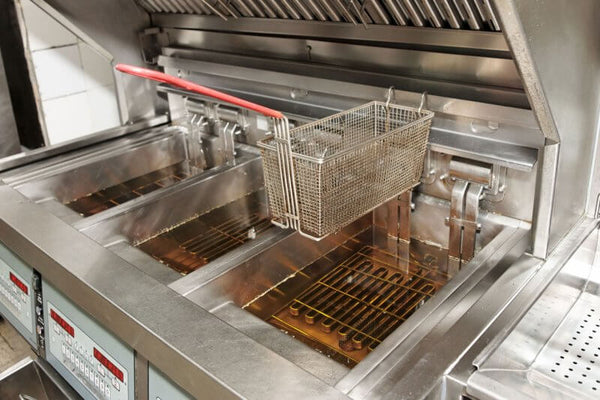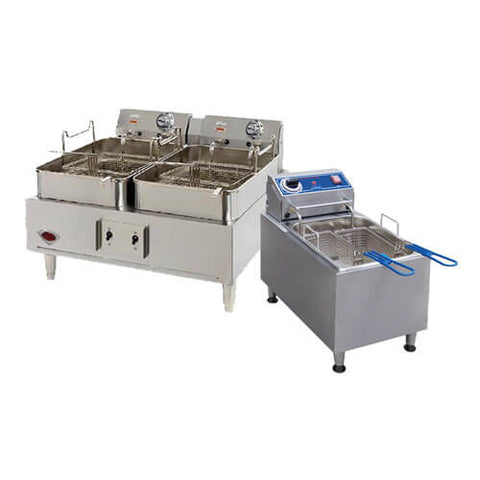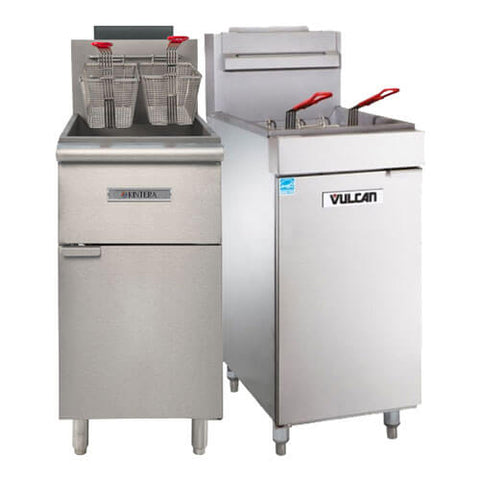Commercial Fryer Buying Guide

A commercial fryer is the heart of many kitchens, depending on the type of food you’re serving during the lunch rush. There are several types of fryers, frypots, fuel options, capacities, and specialty fryers for items like funnel cakes. Here’s how to buy the best commercial fryer so you leave nothing to chance.
Countertop Deep Fryers

Shop Countertop Deep Fryers
Efficient, space-saving countertop deep fryers are commercial workhorses. Countertop-sized fryers take up minimal space in your kitchen while delivering reliable, consistent performance. There are nearly as many types of cuisine and styles of cooking as there are types of countertop deep fryers based on your needs.
Types of Frypots
The primary difference between deep fryers is the style and shape of the frypot. Depending on the type of food you are frying, whether battered or breaded, you’ll need more room for the sediment to safely collect. The type of frypot determines where the sediment that breaks off the food you’re frying goes, and what happens to it. This has a substantial impact on the overall taste of your final product, and different frypots are more ideal for certain recipes.
- Tube-type Frypots: These models contain several tubes that rest above the bottom of the frypot. This creates a “cold zone” where sediment can collect at the bottom without overheating. Tube-type frypots are the right choice for high-sediment items like breaded fish or cheese sticks, especially when your menu calls for heavy, frequent frying.The components in tube-type frypots make them more difficult to clean, but there is typically less scorched debris to remove. The oil in a tube-type fryer lasts longer, and this type of frypot is the most versatile available.
- Open-pot Frypots: These types of frypots contain no tubes or burners, and the bottom narrows into a “V” shape for a smaller cold zone. The frypot is heated externally. Open-pot frypots are well-suited to foods that generate a low amount of sediment, like french fries, chicken wings, or hash browns.The open-pot design is easy to clean and maintain, plus this option is the most affordable. An open-pot design is less energy efficient than a tube-type, but it is also less prone to failure.
- Flat-bottom Frypots: Flat-bottom frypots are also externally heated, and as their names suggest, the bottom of the frypot is flat. Flat-bottom frypots work exceptionally well for battered items like doughnuts and funnel cakes. Baskets are not often used. Instead, the battered items sink to the bottom and then rise to the surface after cooking.There is no cold zone in a flat-bottom frypot, so sediment will continue to cook and can create a burnt taste in the oil. For this reason, these frypots are not recommended for breaded food items.
- Electric Frypots: The frypot of an electric fryer contains heating elements that are directly submerged in oil. Electric frypots are therefore the most heat-efficient and can provide faster temperature recovery. Most electric frypots have cold zones below the burners and offer lift-out elements for cleaning access.
Gas vs. Electric Commercial Fryers
Your deep fryer will either be powered by natural gas, propane, or electricity. The decision will largely be economical. In most parts of the country, gas is less expensive than electricity, so electric models are more costly to operate. You should also consider where the gas lines are in your establishment, as electric fryers are more portable. In many cases, the limitations of the building will make the decision for you.
- Gas commercial fryers provide many benefits. Gas power is available in most commercial kitchens, and more frypot options exist when you choose gas. Gas fryers heat up faster when you first turn them on, and they can reach higher cooking temperatures than electric fryers. Because they are more common, it is more likely that your employees will know how to use and clean a gas-powered fryer. Energy-efficient gas fryers will be easier on your utility usage, but the BTU restriction will lower the recovery heat time on the oil and could lead to a stressful situation in high-volume restaurants that require a fast fryer.
- Electric commercial fryers come with their own advantages. Electric fryers are simpler to install and more mobile since they aren’t tethered to a gas line. Submerged burners in electric fryers make heat transfer more efficient. Electric burners have a faster recovery time than gas fryers, and less heat is lost because the burners are submerged.
Factors to Consider
- Cost – Countertop models are more cost-effective than floor fryers, but you shouldn’t skip straight to the cheapest model. If you want high-quality food and limited maintenance, investigate the average lifespan of a fryer and the projected maintenance costs.
- Capacity – Another consideration is the amount of food you make on a daily basis. A countertop fryer is smarter if you have a manageable amount of orders throughout the day, so you only fry what you need. But with franchises with constant foot traffic, you may want a higher-capacity model.When shopping around for fryers, a general capacity guideline is to estimate 1.5 to 2 times the oil capacity of the equipment per hour for the average fryer output. Size and capacity are just as important as the type of food you plan on frying.
- Menu – The type of commercial fryer you select will be primarily based on your menu. As we covered earlier, if you are frying dozens of donuts per hour, your needs will differ from that of a restaurateur looking to maximize french fry production in the kitchen.
Floor Fryers
Shop Floor Fryers
Floor fryers are essential kitchen tools for a fresh course of appetizers or fried entries. If you have ample floor space in your kitchen and a steady stream of orders, invest in a floor fryer that has a larger capacity than a countertop commercial fryer.
Gas vs. Electric Floor Fryers
While electric floor fryers definitely exist, most large-capacity models will run on natural gas. Gas floor fryers typically cost less than electric models, and with the implied costs of a larger unit, choosing gas reduces overhead investment. As with countertop fryers, gas floor fryers take less time to heat up when turned up and reach higher cooking temperatures. The ultimate decision on fuel type will depend on your budget and the setup in your commercial kitchen.
Factors to Consider
- Cost – Floor fryers come with a heftier price tag than countertop fryers. The price will only rise as the capacity increases, so it’s worth the time to carefully calculate the amount of food you predict you’ll need to fry per day. If you choose too small a fryer, your cooking times will increase, but don’t buy a floor fryer that goes underutilized.
- Capacity – The most obvious reason to buy a larger floor fryer is the volume of food you’ll be frying. If you are a large establishment or have a wide variety of menu items that must be fried, a floor fryer will serve you better than a countertop deep fryer.
- Cleaning – Maintaining a floor fryer requires daily filtering and cleaning. Every couple of weeks, you must remove all of the oil for a deep cleaning. This may need to happen more often based on the volume of food you fry per day. Factor in the cleaning time when choosing between a countertop and floor fryer.
Commercial Deep Fryer Maintenance
All commercial deep fryers must be cleaned to remove sediment and ensure the taste of the oil is not compromised
Cooking oil should be filtered at least once a day, and even more when you fry consistently high volumes of food. Between shifts, you should also schedule a full cleaning of your fryer to remove all food sediment from the frypot. If the manufacturer recommends boiling water to clean the fryer, remember to dry the frypot before use or oil could splatter and burn the person using the fryer.
Stocking your kitchen with vital fryer accessories can make the cleaning process easier and streamline your cooking. If your fryer doesn’t have built-in filtering, fryer filters can significantly extend the lifespan of your oil.
Fryer screens catch large chunks of sediment, which also helps prolong the time between cleanings. Of course, you should stock extra baskets so your fryer is always fully operational.
French fry scoops are handy accessories that take the hassle out of transferring fries from your fryer to serving containers. Increase the efficiency and cleanliness of your fryer with important accessories.
Choosing the Right Fryer for Your Restaurant
Choosing a commercial fryer is pivotal to the success of your restaurant or hotel kitchen, but our professionals are on-hand to guide you through every step of the process. Our commercial fryer experts can help you assemble a dynamic kitchen and find the right fryer for your needs, whether you’re running a food truck or a four-story bar and grill.
Reach out to us today to discover what top-quality, high-powered commercial deep fryer will best benefit your professional kitchen.





















